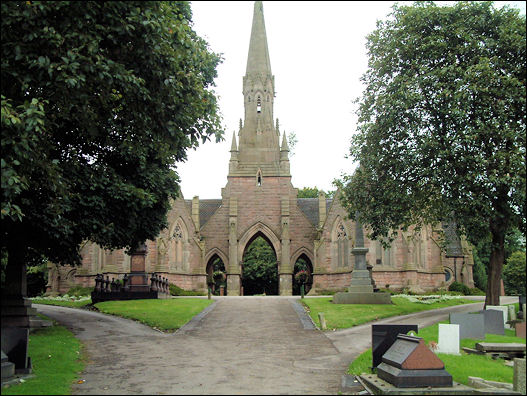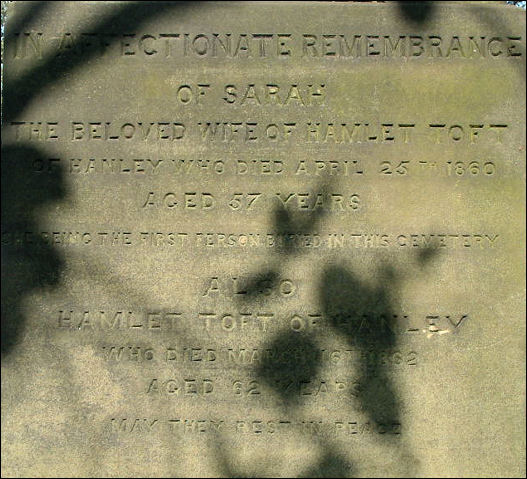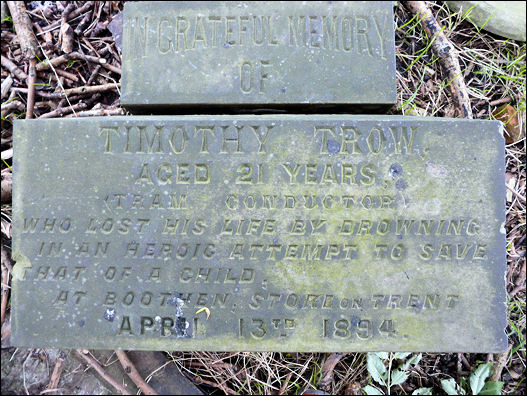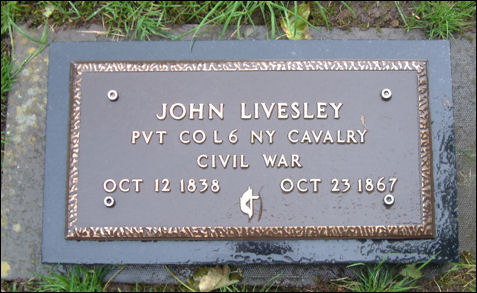|
the history of Hanley Cemetery
  
click the
"contents" button to get back to the main index
next: Tunstall Cemetery
previous: Longton
Cemetery
|
Historian Fred Hughes
writes....
The words
of the poet W. H. Auden, “Death is like the roll of distant thunder at a
picnic,” carries immense aura among the forests of granite in Hanley
Cemetery. Yet, in such lovely surroundings, Auden’s words speak more for
life than of death. The picnic fragrance of freshly cut grass and the
pungency of a distant wood fire are more appropriate to the living than
the departed. Here, along the gentle slopes wedged between the Cauldon and
the Trent and Mersey Canals, I meet companions Pat Simm and Gillian
Carter.
“It’s one
of the pleasures of my day,” says Shelton resident Pat age 67. “It’s easy
to say I come here to visit my husband’s grave. But it’s more than that.
There’s a peace about this place that gives me great pleasure.”
While Pat
and Gillian, from Hartshill, sit beside clusters of poplar and alder,
Pat’s old Labrador Molly stretches lazily on the grass completing the
idyll. “It’s the tranquillity here, and the pleasant pastures that lead to
the canal side. It’s like an oasis in the heart of the city where
everything stops,” Gillian agrees.
|
It was
in the 1850’s that a number of prominent inhabitants proposed that the
newly-formed Hanley Borough Council should provide a public park for its
citizens.
“And they
couldn’t have picked a better place,” says historian Steve Birks. “The
location for the park was to be on land belonging to the Shelton Hall
Estate built in 1782 by the Chatterley brothers. Shelton Hall’s spacious
gardens would make an ideal pleasure ground looking across the valley to
Hartshill and Wolstanton.”
But some
inhabitants had other ideas, one of whom was John Ridgway.
“Interestingly Ridgway, an important pottery employer, opposed the
suggestion of a park arguing that a public cemetery was a more urgent
facility,” Steve continues. “When Hanley became a borough in 1857 Ridgway
was its first mayor. He had to make the decision – Pleasure Park or Morbid
Graveyard. Ingeniously he managed to combine the two. The cemetery was
opened in 1860 and Hanley Park was deferred until 1897 eventually built on
the other side of Stoke Road.” |
The
Staffordshire Advertiser covered the opening on a glorious May Day in
1860 reporting that a 2000-strong crowd cheered Ridgway and the Bishop of
Lichfield’s arrival at the new, Regency-styled, Cemetery Road where the
consecration of the chapels was made.

The chapels at Hanley cemetery
“The
chapels building really is something special,” says Steve. “Each one is
actually a separate entity connected by three open archways. The centre
was designed for carriages with pedestrian access through two side arches.
The whole is made from shaded sandstone with a central tower surmounted by
a spire. And the floors are paved throughout with Minton encaustic tiles.
There’s no doubt that Hanley’s cemetery chapels are architecturally the
most impressive in Stoke on Trent, but I fear they’re being allowed to go
to rack and ruin. Maybe it’s a sign of the times. Fenton cemetery chapel
was demolished in 2001; Burslem chapel is about to be demolished. And even
though Longton and Hanley chapels are listed buildings and protected from
summary demolition, I’m afraid the condition is being allowed to
deteriorate fast.”
In front
of the chapels is the prominent monument of the first town clerk of Hanley
Edward Challinor. Nearby are the family graves of the Huntbach’s,
pioneering department store owners. And all around are memorials to the
Hanley Victorians who made the town great – Pidduck, Goodson, Mayer – each
with a street named after them. The famous Shirley family, and the
Twyford’s; the Dudson’s and ‘Honest’ Sam Clowes, the first working potter
to become a Member of Parliament. And many more, so many that I seek out
Shelton resident Don Maddocks to guide me.

the grave memorial
of Sarah Toft
- in the Roman Catholic area of the cemetery-
"she being the first person buried in this cemetery"
“There
had already been a couple of burials before the official opening,” says
Don, age 83. “The first was Sarah Toft of Hanley who died April 25th 1860.
The memorial actually says she was first person to be buried here.”
Don leads
me through a maze of gravestones with expert familiarity.

Gravestone of
Timothy Trow
In grateful memory / of
Timothy Trow / Aged 21 years / Tram Conductor
who lost his life by drowning
in an heroic attempt to save / that of a child
at Boothen Stoke-on-Trent
April 13th 1894
“You know
about the memorial to Timothy Trow, the young man who died saving a child
from the canal at Stoke? Well here’s his family grave,” he indicates. “The
plain granite cross has been pushed over for safety reasons by council
officials,” he says. An outrage, I respond silently.

bronze plaque to the
memory of John Livesley
who died in the American Civil War
JOHN LIVESLEY/ PVT CO L 6
NY CAVALRY/
CIVIL WAR/ OCT 12 1838 OCT 23 1867
And then
we’re off in search of other icons – a curious rusting cast iron memorial
to the Hawley family; a bronze plaque to Private John Livesley, a soldier
in the New York Cavalry during the American Civil War. Two brothers age 17
and 18 killed in the Sneyd Pit disaster on New Years’ Day 1942. Closer to
the canal are the memorials to Madame Reymond and her protégé John Cope,
founder and conductor of the North Staffs Symphony Orchestra respectively.
“Can you see what’s happened here,” cries Don. “Someone’s pushed this
memorial over and probably made it more unsafe than before. Why the
council can’t preserve all this history instead of allowing the memorials
to deteriorate is beyond me.”
I nod in agreement.
 more on Hanley
Cemetery
more on Hanley
Cemetery
|
![]()
![]()
![]()